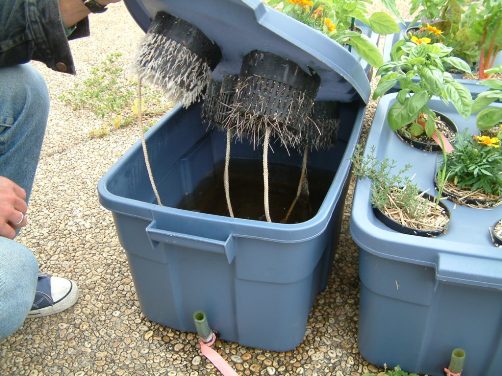Why should I or anyone start a hydroponics garden? Let’s start with the state of modern farming….

Over the past century or so, the small farm has been gobbled up by large commercial corporations. Farming is now approached with a purely business/profit mind-set rather than an approach where ‘you provide for the land and it will provide for you and your family’.
Land is now farmed for an extremely high yield per acre so crops are planted closer together and large amounts of fertilizer are used to increase crop yields. This can upset the natural soil balance and result in lower yields forcing even more fertilizer to be used. This along with the soil compaction created by heavy farm machinery can cause erosion. America is losing tons of topsoil every year reducing the amount of farmable land. Hydroponics is a good alternative to producing fruits and vegetables and will help stop this cycle of lost topsoil. In fact, you cannot go into a grocery store now without seeing a sticker on some vegetable saying ‘hydroponically grown’.
And what does this mean to the individual hydroponics hobbyist? The same advantages and disadvantages with growing hydroponics apply to large corporations as well as to the individual.
Advantages over Soil Gardening
- Much greater yield per square foot of garden space – a small growing system will produce enough vegetables to regularly supplement a small family’s diet.
- Water and fertilizer is reused.
- Hydroponics gardens can be used when there is no land available for gardening or can be set up indoors, off season, as well as outside.
- There are fewer pests and disease when soil is not used as the growing medium.
- Plants grow faster and yield more.
- Plant growth does not rely on seasonal factors – an indoor system can function adequately in the winter as long as it is kept warm.
Disadvantages Compared to Soil Gardening
- The cost of initially setting up
- Increased electric bills for such items as the water pump (if used) and the plant lighting system (if set up indoors).
- Another disadvantage is the complexity of set up. No matter how simple the hydroponics growing system it is still more complex to build and manage compared to soil gardening.
Still, in my opinion, the advantages definitely outweigh the disadvantages and will give you a working garden even if you are an apartment dweller with no space for a garden.
Getting your Feet Wet With a Simple ‘Container’ Type System
Container hydroponics systems are small vessels holding a growing medium and one or more plants such as a tomato plant in a bucket filled with pebble stone.
This pot is periodically manually flooded with aerated nutrient solution and drained, allowing the plant to receive all required nutrients for successful growth. Therefore the container must have a means to drain the nutrient solution when needed such as a spigot that can be turned ‘on’ as well as ‘off’. These types of container hydroponics systems are generally the simplest of all the types of growing systems.
One simple method could be a tomato plant in a bucket filled with pea stone. The bucket (bucket #1) would have a spigot near the bottom that can be turned off and on. This bucket could be placed on a support 2 feet off the ground and have a hose attached to the spigot hanging into a second bucket (bucket #2) containing nutrient solution (this bucket is on the ground). Twice a day, you could dump the nutrient solution from bucket #2 into bucket #1, with its spigot turned off, until the nutrient solution level reaches the top of the pea stone. Wait a half hour or so and open the spigot to drain the solution back into bucket #2.
This is a nice-and-easy manual system guaranteed to be successful. All you would need for such a system is a hydroponics nutrient fertilizer, available online at any hydroponics store, 2 buckets, 1 with a plastic spigot near the bottom, a hose to connect to the spigot and some small rocks to use as growing medium…and, of course, a tomato plant.
To set up the system, fill bucket #1 about ¾ full with clean (rinsed) pea stone or small rocks. Transplant the tomato plant into the bucket filled with pea stone (bucket #1), gently rinsing all the dirt off the plant roots until clean being careful not to touch the roots or the stem of the plant which would damage it. Now simply plant the tomato into the pea stone the same way you would plant it into your garden. Fill bucket #2 with water keeping track of how much water is used and mix in some hydroponics fertilizer according to the directions on the package. Start the growing cycle by dumping this solution from bucket #2 into bucket #1.
Every week make up new nutrient solution for bucket #2 by mixing a certain amount of water with a certain amount of hydroponics fertilizer according to the directions on the nutrient package otherwise the pH of the solution may reach a point where it will hurt the plant. And, each day ‘top off’ the nutrient solution with plain water if needed. You will find that as your tomato plant grows larger, it will consume amazing amounts of nutrient solution so be sure to monitor the water level.
What to do with your old nutrient solution when it is time to replace each week with fresh solution? Water your houseplants or garden plants with it – they will love you for it.
Larry Maki is an avid, self-taught hydroponics gardener with a passion for alternative types of gardening.
Related Articles & Free Email Newsletter
Natural CO2 Enrichment for Indoor Gardening
The Essential Elements of Hydroponic Nutrients




Comment here